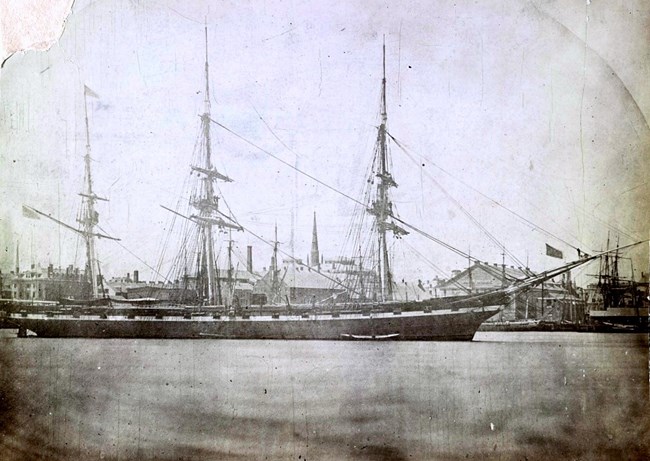Last updated: September 2, 2018
Article
David Farragut

US Naval History and Heritage Command, photo # NH 49527, courtesy of Mr. Franklin Bache Huntingon.
Walk north of the White House along Connecticut Avenue and you will come across a fairly unassuming statue of a man looking out over the horizon. This is America’s first Admiral, David Farragut. In a lifetime of service beginning at the age of nine, David Farragut represented American ideals of bravery, loyalty and honor. Respected even by his foes, David Farragut fought with integrity for the continued existence of the United States of America. His contributions on the water matched those of General Ulysses S. Grant on land during the Civil War. Largely forgotten today, his service is remembered here in the nation’s capital.
David Farragut’s father George was a Spanish sailor who entered American service during the Revolution. His father’s service led to young David Farragut becoming a Midshipman in the US Navy before the age of ten. He first saw combat in the War of 1812. His ship, the frigate Essex was sent to the Pacific to raid British shipping. The teenage naval officer captained prize ships, explored the Galapagos Islands, and survived a ferocious battle with the Royal Navy in which his ship was lost and he was taken prisoner. Battle hardened David Farragut was paroled towards the end of the war back to the United States. He had suffered great ordeals in his early adventures but came through a stronger and better leader. Back in the United States Navy, Farragut would go on to fight pirates, serve in the Mexican-American War, build the Mare Island Naval Yard in California, and work his way up to the rank of Captain.
At the outbreak of the Civil War, David Farragut was living in Norfolk, Virginia. He was expected by many to side with the Southern Secessionists. Farragut had been born in Tennessee. He was a Virginian by choice and had married a Southern lady, Virginia Loyall. Yet a life time of service had endowed Captain Farragut with a deep unbending loyalty to the United States. When Virginia voted to secede, Farragut went home to his wife. He told her that he must, “stick with the flag”. He offered her the choice to return to her family who supported the Confederacy or go north with him. Their love remained strong and the couple with their young son took a ship to Baltimore.
Farragut had demonstrated great loyalty to the United States by leaving his home and all he owned behind, but was still distrusted by some at first for his Southern heritage. He was turned down for a combat command for the first half year of the war. Yet the navy was expanding rapidly and it needed all the skilled leaders it could get. The navy department overcame its initial reluctance to assign Farragut, after the testimonials of Farragut’s peers to his loyalty, bravery and skill. In January 1862, Farragut was assigned to command the West Gulf Blockading Squadron. His first job was to close the Mississippi River down to Confederate commerce.
Captain Farragut quickly proved himself an aggressive leader. He led his squadron past Confederate forts and gunboats to capture New Orleans in April 1862. It was one of the first major Union victories of the Civil War. Farragut followed up this triumph by capturing Baton Rouge and bombarding Vicksburg. Yet standing victorious Farragut was magnanimous to the people in the cities he had captured. They might have been in rebellion, but ultimately they were American citizens whom he had sworn an oath to protect.
In honor of his victories, President Lincoln promoted Farragut to the rank of Rear Admiral. Prior to this the senior rank in the US Navy had been Captain. The navy had done without Admirals, because the title had long been associated with European Royalty. The navy recognized, however, that since it was fighting the largest American war to date it needed leaders to take overall command of its ships. David Farragut was the first US naval officer so honored. In 1864 he became America’s first Vice Admiral. After the Civil War’s conclusion, Farragut would be further honored by becoming the first full Admiral.
Farragut’s greatest moment came on August 5, 1864. It was on that day that Admiral Farragut led the US fleet into Mobile Bay in order to shut down the Confederacy’s last great port in the Gulf of Mexico. Leading from his flagship the USS Hartford, Farragut led a fleet of eighteen ships into Mobile Bay. The US Fleet had to run a gauntlet of Confederate forts, torpedoes (as mines were then known), and Confederate warships, including the powerful ironclad ram, the CSS Tennessee. When one of the lead ships, the USS Tecumseh, hit a torpedo and sank with most of its crew, the Union fleet stalled. Their way was blocked by a minefield, but to stay under the guns of the forts would have been suicide. The only options were to retreat or sail through the minefield. To get his fleet moving and out from under the fire of the Confederate forts, Farragut issued his immortal order, “Damn the torpedoes, full speed ahead!” He was risking his life and the lives of those under his command, but he knew that unless he brought his fleet into the bay the Union would lose the day. In order to rally his men Farragut had himself lashed to the rigging in full sight of his men and the enemy as well. He would live or die with his men. Farragut’s courage worked and the fleet moved forward. Once past the gauntlet, Farragut brought the USS Hartford into close combat with the CSS Tennessee. Battered by the US fleet for three hours, the Tennessee surrendered. The last major Confederate port on the Gulf was closed.

Library of Congress
